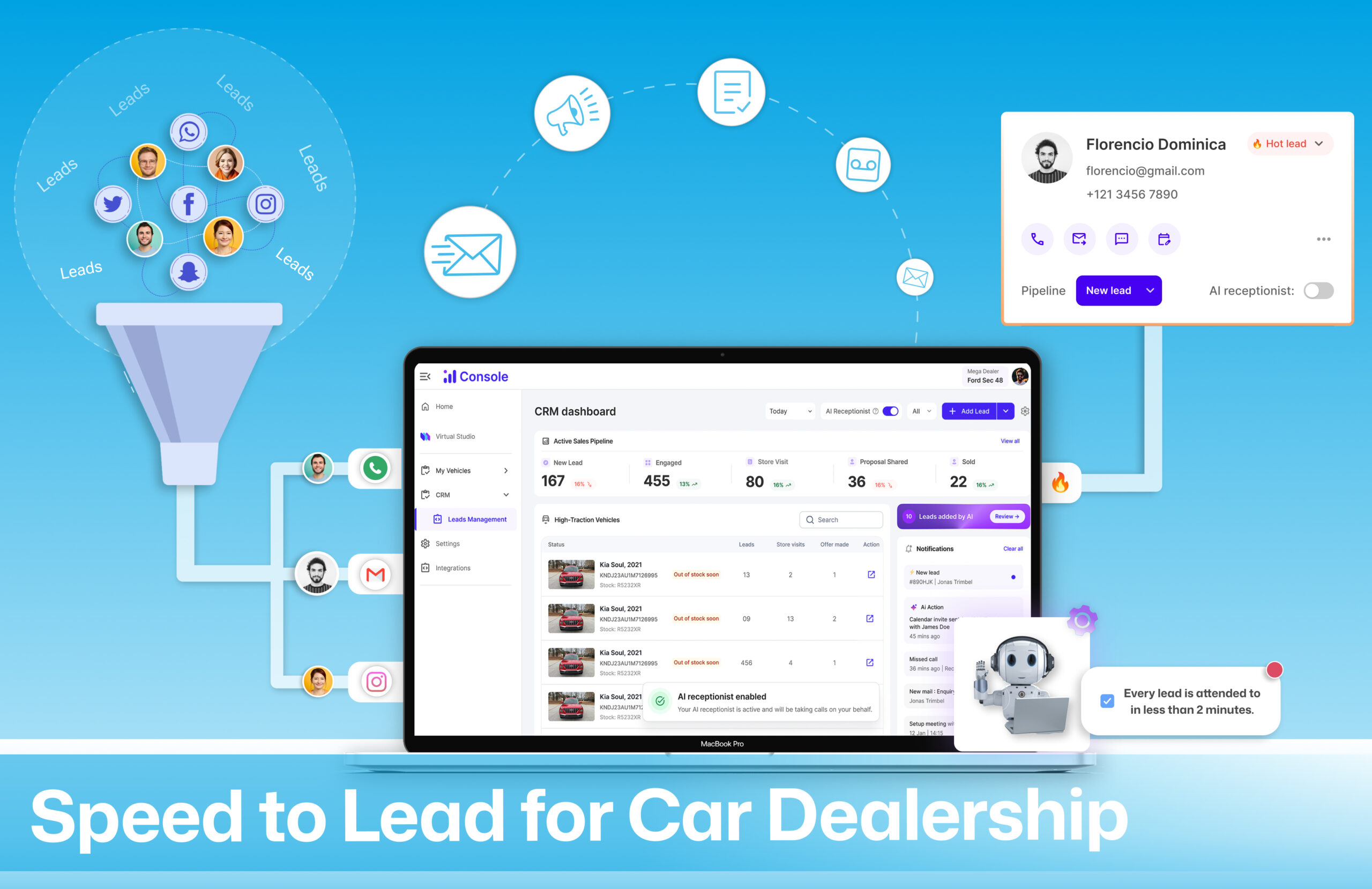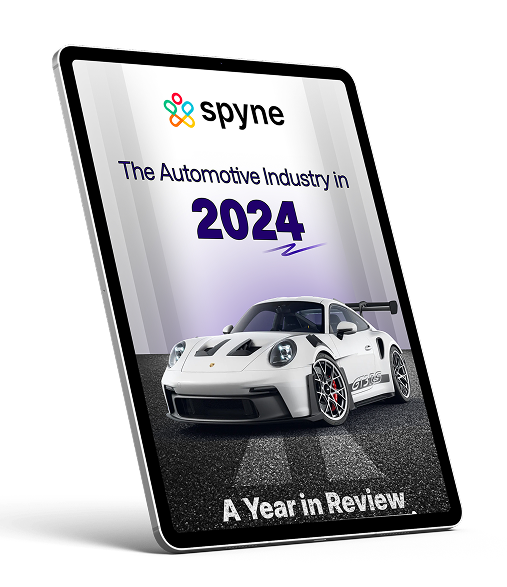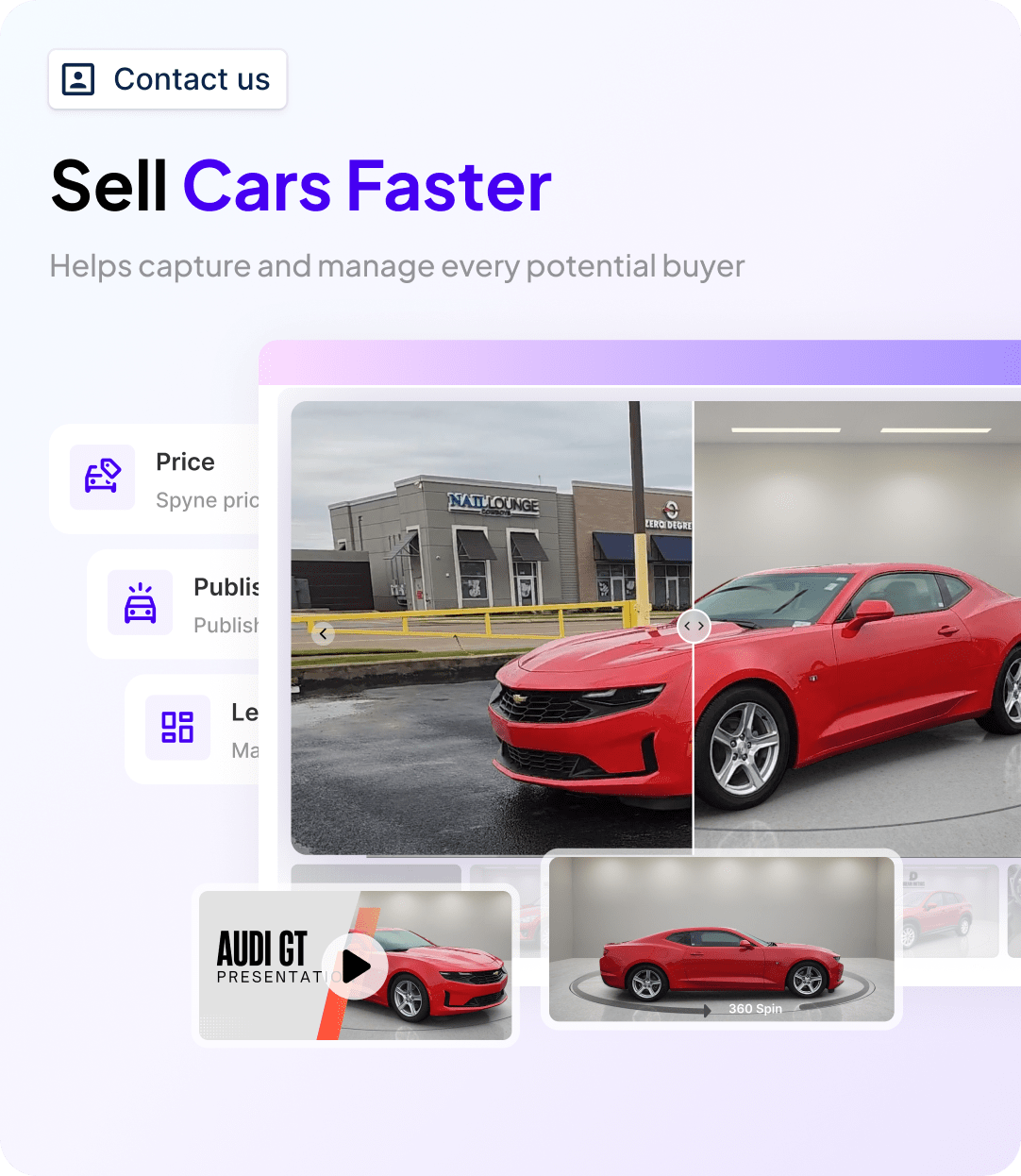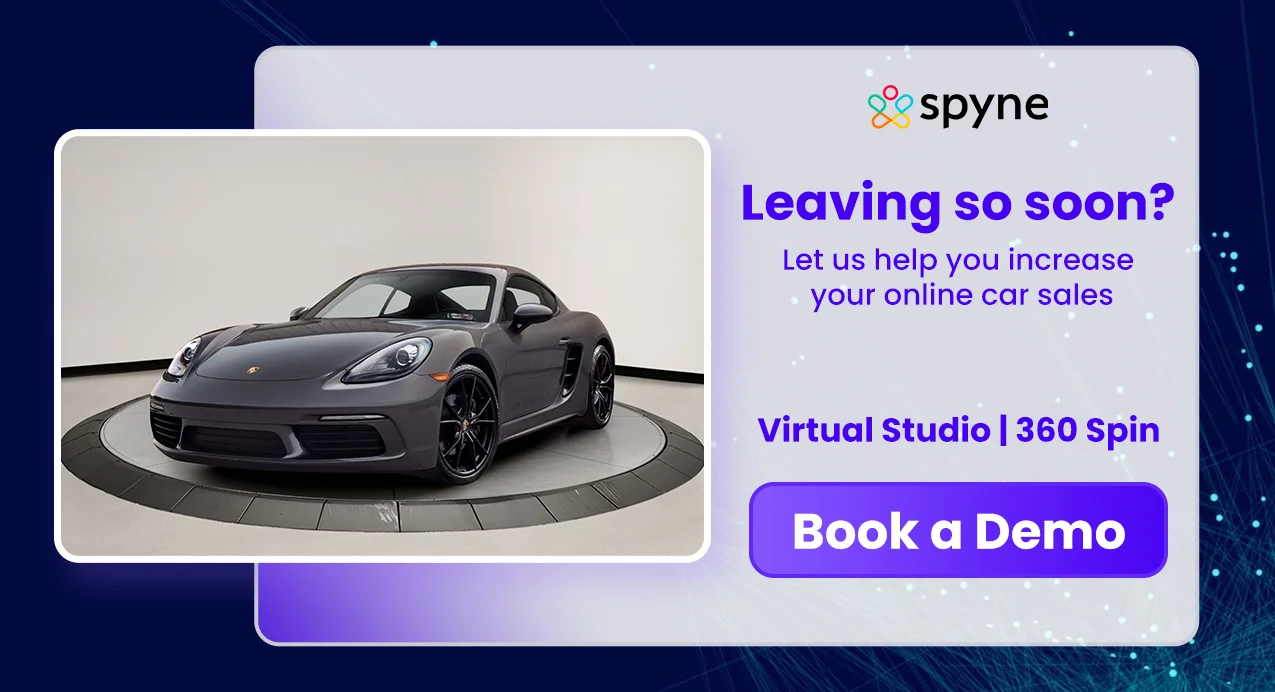Speed to lead is the amount of time your dealership takes to respond to customers once they are expressing interest. In the competitive car market of today, prompt responses can seal or kill a sale. Consumers want quick responses, and dealerships responding in minutes increase their chances of turning leads into customers. This blog discusses why speed to lead is important and how you can enhance your response time to achieve more sales.
What is Speed to Lead for Car Dealerships?
Speed to lead is how fast your dealership replies to someone after they show interest, like filling out a form, calling, or sending a message. The moment they contact you, the clock starts ticking. If your team replies in 10 minutes, your speed to lead is 10 minutes. If you wait 2 hours, you might lose that customer to another dealer. It doesn’t matter how the lead reaches out, from phone, email, live chat, or social media, every second counts. Many dealerships track their average response time by adding all response times together and dividing by the number of leads.
Quick follow-ups help increase your chances of making a sale. Today’s car buyers expect fast answers, and dealerships that respond quickly often win more deals. Speed to lead is key to better customer service and higher conversions.
The Power of Speed to Lead: Shocking Lead Response Statistics
Did you know how fast you respond to a lead can make or break your sales? Here’s why speed to lead statistics is crucial:
- Immediate Contact is Crucial: Reaching out within 5 minutes makes you 100 times more likely to have a meaningful conversation compared to waiting 30 minutes.
- Quick Conversion Boost: Contacting leads in the first 5 minutes increases your chances of converting them into sales opportunities by 20 times.
- The One-Minute Advantage: Responding within the first minute can lead to a massive 391% increase in lead conversions, showing just how vital every second is.
- First Responder Advantage: 78% of buyers choose the company that responds first, making rapid follow-up a key competitive edge.
- Time Kills Leads: After 5 minutes, the odds of qualifying a lead drop by 80%, and waiting 30 minutes means you’re 21 times less effective.
- Most Businesses Are Slow: The average B2B response time is a disappointing 42 hours, with 63.5% of companies failing to respond at all.
- Missed Opportunities: Only about 27% of leads receive follow-up, and less than 25% get direct phone contact, leaving many prospects cold.
- Automotive Industry Insights: Car shoppers visit multiple websites and spend over 6 hours researching. Over 66% of dealership leads get no response within 24 hours, and 37% are mishandled or lost.
- Engagement Timing Matters: Nearly 57% of buyers purchase within 3 days of contact. Live, personalized responses achieve up to 30% engagement, far higher than after-hours or autoresponder replies.
- Huge Market Opportunity: Only 7% of companies respond in under 5 minutes, presenting a major chance to stand out by acting faster than competitors.
Benefits of Using Speed to Lead in the Automotive Industry
In the fast-paced automotive industry, speed to lead is crucial for success. By responding quickly to leads, businesses can significantly increase conversion rates and improve customer satisfaction.
1. Enhance Lead Conversion Rates
Addressing car sales leads on time can grow customer conversion rates from visitors to buyers. For instance, calling a lead within a minute can enhance chances of conversion by 391%. Five-minute or less speed to lead times is optimal for approaching prospects and finishing the deal more quickly.
2. Enhance Lead Quality:
Quicker follow-up enhances lead quality by involving customers when they are most interested. Harvard Business speed to lead review discovered that dealerships responding within one hour were almost seven times as likely as those responding later to qualify leads.
3. Enhance Sales Process Efficiency
Alignment of sales and marketing forces and the use of automation features such as lead routing, progressive dialing, and dealership email marketing can enhance speed to lead without compromising on personalization. This results in greater efficiency and improved prioritization of potential leads.
4. Boost Website Conversions
Using tools such as live chat, chatbots, demo requests, call scheduling, and automated SMS confirmations helps engage website visitors immediately. This reduces lead decay and improves conversion rates by making your dealership more accessible and responsive.
5. Gain Competitive Advantage
More than 55% of companies take over five days to respond to leads. Responding quicker than others will win more opportunities, stopping leads from being given to someone else. Being the first to respond also means that brand recognition is enhanced and a good reputation is built.
6. Build Customer Loyalty
Quick responses indicate to customers that their time is important, which gains them trust and loyalty. For instance, Zappos excels in quick customer service response, responding many times within minutes, which earns them a loyal customer base and good word of mouth.
7. Drive Higher Profitability
Streamlining lead delivery and response operations can lead to greater conversion ratios and more revenue. Studies demonstrate that seven or more follow-ups may result in 15% more connections; hence, speed to lead is an important driver for business growth.
How to Effectively Use Speed to Lead in Sales
Getting back to a lead on time can be the difference between sales and no sales. The sooner you get back to someone after they’ve expressed interest, the more likely they are to become a customer. Here’s how you can use speed to drive sales:
1. Get Your Landing Pages to Work Smarter
When a user arrives on your site, you want them to act immediately. That might be filling out a form, scheduling a demo, or clicking to call your reps.
- Keep it simple and in the zone.
- Include clear calls to action with easy-to-use forms.
- Include live chat or a chatbot so individuals can ask questions now.
- Ensure that anything they provide directly goes into your car dealer CRM, so your sales force can follow up quickly.
This allows you to catch leads before they lose interest.
2. Use Chatbots Correctly
Chatbots can automate and initiate conversations even when your staff is offline.
- Program them to alert you when someone interacts.
- Let the bot assist in scheduling appointments or gathering basic information.
- Integrate your chatbot with your CRM, so your staff knows whom to call.
- Don’t just rely on one channel; follow up via email, chat, or even video if necessary.
The objective is to keep the conversation alive without making the lead wait.
3. Direct Leads to the Right Individuals Immediately
Once a prospect expresses interest, you need to ensure that they reach the right sales representative.
- Utilize automated systems to direct new leads to available representatives.
- Distribute leads on the basis of where they’re from, what they’re interested in, or what they need.
- Configure notifications so that your team is aware when a new lead is available.
The quicker you distribute leads, the quicker your team will react.
4. Implement Live Chat and Click-to-Call on Your Site
At times, individuals merely want to communicate with somebody immediately. Automotive Live chat or click-to-call functionality provides them the capability to do so.
- Use chat to respond fast and build trust.
- Make bots do the simple things, then hand the lead off to a human when necessary.
- Configure chat to only appear for qualified leads so you don’t get swamped.
- Customize chat messages based on who’s on your site.
These technologies enable you to converse with leads in real time, when they’re most engaged.
5. Follow Up Quickly and Through Multiple Touchpoints
It’s crucial to get the initial response fast, but also to stay in contact.
- Follow up with emails or texts within minutes of receiving a lead.
- Teach your staff to call new leads on time.
- Don’t hesitate to contact more than once, persistence has its rewards.
- Utilize alternative channels such as email, phone, chat, and even social media.
Make clear guidelines for how quickly your staff should respond and hold everyone accountable.
6. Score and Sort Your Leads
Not all leads are ready to purchase. Utilize lead scoring to determine who’s likely to convert.
- Assign higher scores to leads that display interest or match your ideal customer.
- Utilize tools to complete missing information and enrich lead profiles.
- Ensure marketing and sales teams define what a “qualified” lead is.
This enables your team to prioritize the correct leads first.
7. Monitor and Get Better Over Time
Speed to lead isn’t so much about speed as about getting better over time.
- Monitor how quickly your team responds.
- Identify where things get slower, such as manual processing or missed notifications.
- Use simple dashboards to monitor performance and spot issues.
- Reward your team for quick responses and make it a part of your sales culture.
The secret is to continuously check in and make incremental changes to remain ahead.
12 Tips and Tricks to Master Speed to Lead in 2025
Following is the list of 12 tips and tricks to master your speed to lead.
1. Know Who You’re Talking To
Take a second before contacting a lead to get an idea of who they are. Check their job title, company, location, and what they’re searching for. This keeps you from wasting time with people who aren’t a good fit and allows you to concentrate your energy on the leads that truly count.
2. Let Tech Do the Heavy Lifting
There are technologies available that will auto-score your leads, send emails, route conversations to the correct person, and even make first contact. Utilise them. Automation doesn’t equal less personal, it equals faster, more consistent touch without wearing out your team.
3. Build a Simple, Repeatable Process
Ensure your lead-handling process is simple to follow and still gets the job done even when things get hectic. Establish rules for a “qualified” lead and have tools automatically assign them. Maintain the process tightly so you don’t miss good leads.
4. Get Sales and Marketing on the Same Page
Your marketing and sales teams need to work together. Marketing generates the leads, and sales convert them into customers, but only if they’re communicating and exchanging information. Have open check-ins, share the same tools, and concur on what “good” looks like.
5. Repair the Slow Areas
Notice where your flow gets bogged down, perhaps it takes too long to return a call, or your forms are asking too many questions. Employ solutions that pre-populate data or enable reps to call more quickly. Every minute saves money, so trim the fat wherever possible.
6. Automate Following Up (But Not Robotically)
Set up emails or texts that go out right after someone shows interest. Use their name, mention what they asked for, and offer to help. Mix in personal touches like a phone call, so it doesn’t feel cold or robotic.
7. Test Yourself Like a Customer
Act like you’re a customer. Fill out your forms and time how long it takes to receive a response. Repeat every few months. If slow, correct it. Quick responses win business, it’s that easy.
8. Personalise Everything
Don’t send “Hi there” emails. Address the lead by name. Refer to their business or what they searched for. People will respond if they feel you’re addressing them directly.
9. Leverage Great Content to Drive Leads
Create blogs, make videos, and produce informative guides that respond to genuine customer queries. Publish them on the web and provide useful resources for contact information in return. Follow up quickly afterwards.
10. Engage on Social Media
Post frequently, reply, and respond to messages, particularly where your community spends its time. The quicker the response to comments or DMs, the better. It’s not about ads, it’s about showing up.
11. Create a Fast-Response System
Make it simple for your team to find out when there’s a new lead and respond within 5 minutes or less. A phone call is ideal, but email and text are fantastic alternatives. Responding quickly increases your chances of closing the sale.
12. Monitor What’s Working (And What’s Not)
Monitor things such as how quickly you’re responding and how many leads come in as paying customers. Use that information to get better. If you notice something hindering your progress or leads falling off, correct it quickly.
Why Speed to Lead Is Crucial for Business Success?
Speed to lead is a metric that indicates the pace at which a company can act in response to an opportunity, for example, a customer inquiry or a sales lead. It is the time between recognizing a possible customer or problem and taking valuable action. It is vital to react quickly, but it is not a matter of speed alone; it is also a matter of efficiency and effectiveness, providing high-quality responses promptly. In the current fast-paced market, clients anticipate prompt and responsive service. A quick response indicates that you esteem their time and desires, fostering confidence and improving prospects for conversion. Delays, on the other hand, make prospects lose interest or seek alternatives from competitors.
Internally, companies that focus on speed to lead become more adaptive and agile. Quick decision-making enables companies to react to changes, challenges, or new opportunities on time, providing them with a competitive advantage. This is especially crucial in sectors where timing can influence results significantly, such as healthcare or finance.
Research validates the effect of velocity on business achievement. For instance, businesses that reply within the initial hour of lead inquiry are much more likely to engage and qualify the leads. Additionally, facilitating employees to speed up encourages greater motivation and productivity, which also accelerates organizational expansion.
Finally, speed to lead is an elementary driver in winning and keeping customers, remaining competitive, and sustaining operational excellence.
Effective Strategies to Boost Your Speed to Lead
In today’s fast business world, how quickly you respond to new leads can make a big difference in winning customers. The faster you connect, the better chance you have of turning interested people into buyers. Here are some easy ways to help you speed up your automotive lead response and improve your sales results.
1. Set Clear Goals and Priorities
Know exactly what you want to achieve. Set clear and simple goals so you and your team can focus on the most important tasks.
2. Make Decisions Faster
Keep your decision steps simple. Let the right people make quick decisions without waiting for too many approvals.
3. Use Technology to Help
Use tools that automatically sort and rank leads based on how interested they are. This helps your team focus on the best leads right away.
4. Send Leads to the Right People
Give leads to sales reps who work in the same time zone or know the customer’s industry best. This way leads get faster and better responses.
5. Work Together with Marketing
Make sure sales and marketing teams share information and work as one. When both teams help with leads, responses happen quicker.
6. Watch Where Leads Drop Off
Look for places where customers stop moving forward in your sales process. Fix these spots to keep leads interested and speed up follow-up.
7. Make Your Landing Pages Simple and Clear
Use easy-to-understand pages with strong calls to action. Keep forms short and use tools like live chat to make it easy for visitors to contact you.
8. Use Chatbots and Email Automation
Chatbots can answer questions right away, and automated emails can follow up with leads fast. Let customers book demos on their own time with online schedulers.
Measuring and Monitoring Your Speed to Lead in 2025
To get better at following up with leads, you need to keep an eye on how fast your team responds. It’s not enough to just guess; you need to measure it. The quicker you respond to someone who shows interest, the better your chances are of making a sale. This section will show you simple ways to track and improve your follow-up time.
1. Set Clear Goals
Start by setting a goal for how fast your team should reply to new leads. For example, you might want everyone to respond within 5 minutes. These are called KPIs (Key Performance Indicators), and they help your team know what’s expected. You can also set different goals for different kinds of leads, like calls, messages, or website forms.
2. Track Each Lead Source
Leads can come from many placesyour website, online ads, social media, or car marketplaces. It’s helpful to check how fast you respond to leads from each source. If one channel is slower, you’ll know where to focus your efforts.
3. Use Tools to See the Data
You don’t need anything fancy. Most CRMs or lead management tools can show you how long it takes to respond to each lead. Look at this data every week. If response times are going up, you’ll know it’s time to make changes.
4. Get Real-Time Alerts
If possible, set up alerts that tell your team right away when a new lead comes in. This could be through text, email, or your CRM. These quick reminders help your team follow up faster and make sure no lead is missed.
5. Review Performance Often
Pick a day every week to go over your team’s numbers. Look at who’s responding on time and who might need help. Use these meetings to talk about what’s working and what can be better. Keep the mood positive, it’s about improving, not blaming.
6. Make Sure Replies Are Still Good
Don’t just rush to reply. A fast message isn’t helpful if it sounds lazy or rude. Train your team to be quick but also friendly, clear, and helpful in every message or call.
7. Use Simple Reports
It helps to see your numbers in a clear report. This way, you can spot patterns. For example, maybe response times are slower on weekends or in the evenings. When you know the problem, it’s easier to fix it.
8. Change Your Process If Needed
If something isn’t working, like a slow system or a team member who’s always behind, make changes. Small tweaks, like assigning leads better or adding reminders, can lead to big improvements over time.
How to Improve Your Speed to Lead in 6 Practical Steps
Speed to lead has the potential to either win or lose a sale, particularly in the automotive industry. As a BDC representative or dealership marketing manager, speedier engagement equals more conversions. Follow this detailed, product-driven playbook to increase your speed of engaging with leads.
1. Make Your Landing Pages Convert in a Flash
Your landing pages need to do more than capture informationthey need to convert instantly.
- Add chatbot or live chat widgets to greet visitors the instant they land on your site.
- Utilize features such as instant scheduling (like calendar popups) rather than sending visitors off to another page.
- Add prominent CTAs- “Book a Test Drive,” “Get Price Quote,” or “Talk to a Specialist” above the fold.
The aim is to eliminate friction and provide potential buyers with what they need, when they need it. It’s like making a digital handshake in a matter of seconds.
2. Automate Lead Capture and Enrichment
Waiting for people to gather information can slow things down. Use smart forms and automotive lead generation tools to quickly collect important details like budget, car model choice, or ZIP code.
- Make forms brief, but potent. Request only what is essential.
- Use tools such as Clearbit or ZoomInfo to auto-fill missing information.
- Augment form data with CRM tools such as Spyne Connect AI, which records lead source, car preferences, and engagement history in real time.
This enables your sales team to respond quickly and with context.
3. Route Leads to the Right Sales Reps Instantly
Faster doesn’t matter if the lead languishes unassigned in your CRM. Automate routing to eliminate the delay.
- Apply automated lead distribution rules (territory, model, lead score, or availability) within your CRM or DMS.
- Tools such as Spyne Connect AI automatically route leads to the correct reps based on pre-defined conditions.
- Make sure reps get real-time notifications via SMS, app notifications, or email.
No spreadsheets. No guessing. Just leads to the correct person in seconds.
4. Apply AI Assistants for After-Hours & Overflow Leads
Leads won’t always be generated during working hours. That’s where AI comes in.
- Use an automotive chatbot or virtual assistant to talk to leads 24/7.
- Utilize them to reply to FAQs, book test drives, or capture lead information.
- AI speed to lead software, such as Spyne’s Chat AI, can also qualify leads and push high-intent leads immediately to your sales team.
You remain responsive even when your team is away.
5. Create a Lead Engagement Process Your Team Follows
Speed is a result of consistency. You require a smooth system.
- Create an SOP for follow-ups: first touch in 5 mins, second in 1 hour, etc.
- Templates or pre-approved scripts for email, SMS, and chat to cut down thinking time.
- Train your team on response protocol, sense of urgency, and CRM usage so that no lead falls through.
And if feasible, create a rapid-response team just to manage incoming leads.
6. Monitor, Measure, and Optimize
Can’t make what you don’t measure.
- Utilize your CRM to monitor “speed to lead” KPIs, first response time, average rep response time, and so on.
- Mark drop-off areas and bounce rates on landing pages.
- Monitor weekly and reward reps for achieving response time goals.
This establishes accountability and allows you to test and fine-tune your process for even higher results.
How Spyne Accelerates Your Speed to Lead?
Spyne retail AI enables car dealerships to drastically improve their speed to lead the valuable time between lead receipt and first contact via a set of AI-powered tools to automate processes, enrich customer interaction, and increase conversion levels. Let’s see how Spyne revolutionizes this integral element of automotive retailing:
1. AI-Fueled Lead Management with Connect AI
Spyne’s Connect AI forms the cornerstone of its automotive lead management platform, providing:
- Centralized Lead Capture: Consolidates leads from multiple sources websites, social media, and third-party platforms into one dashboard, so no opportunity is missed.
- Real-Time Lead Routing: Automatically routes leads to the most appropriate sales representatives according to pre-defined criteria like location, expertise, or availability, reducing response time.
- Instant Automated Responses: Engages prospects in real-time through customized messages via SMS, email, or chat, keeping them interested and boosting the chances of conversion.
2. More Engaging Visual Tools
Admitting that engaging visuals can speed up customer decisions, Spyne provides:
- Virtual Studio: Allows dealerships to produce high-quality, studio-grade images without professional photography equipment, improving online car presentations.
- 360° Spin and Video Tours: Offers interactive, virtual views of cars, enabling customers to view all sides, which can result in faster buying decisions.
3. Automated Customer Journey Mapping
Spyne’s automotive CRM maps customer interactions across multiple touchpoints, enabling:
- Personalized Engagement Sequences: Tailors subsequent communications based on specific customer behavior and interests, engaging prospects throughout their buying process.
- Timely Follow-Ups: Automates follow-up reminders and notifications for the sales team, ensuring timely and consistent communication with leads.
4. Seamless Integration with Current Systems
Spyne integrates seamlessly with leading Dealer Management Systems (DMS), enabling:
- Rapid Deployment: Reduces setup time and disruption to current processes, so dealerships can begin benefiting from Spyne’s capabilities as soon as possible.
- Integrated Operations: Makes sure that all the speed to lead tool and information integrate perfectly, giving a seamless experience to staff and customers alike.
5. Data-backed Insights and Performance Monitoring
With in-depth analytics, Spyne enables dealerships to:
- Track Key Metrics: Keep track of lead response times, conversion rates, and sales performance to detect areas for improvement.
- Optimize Strategies: Utilize data insights to optimize marketing strategies and sales strategies, thus improving overall efficiency and effectiveness.
6. Real-World Impact
Dealerships using Spyne’s platform have seen:
- 40% Boost in Qualified Leads: Improved visual merchandising and timely interaction help attract more serious prospects.
- 85% Enhancement in Website Engagement: Interactive features such as 360° spins and video tours engage visitors for longer, providing better chances for conversion.
- 60% Shortening of Image Processing Time: AI-powered tools automate content generation, enabling quicker vehicle listings.
Conclusion
Quick response times are essential for converting leads to buyers. Spyne’s intelligent speed to lead tools assist dealerships in automating lead capture, directing inquiries in real-time, and interacting with consumers 24/7. Your staff can increase speed to lead, enhance the customer experience, and boost sales conversions using Spyne, providing your dealership with a strong advantage in today’s marketplace. Book a free demo today with spyne.
















